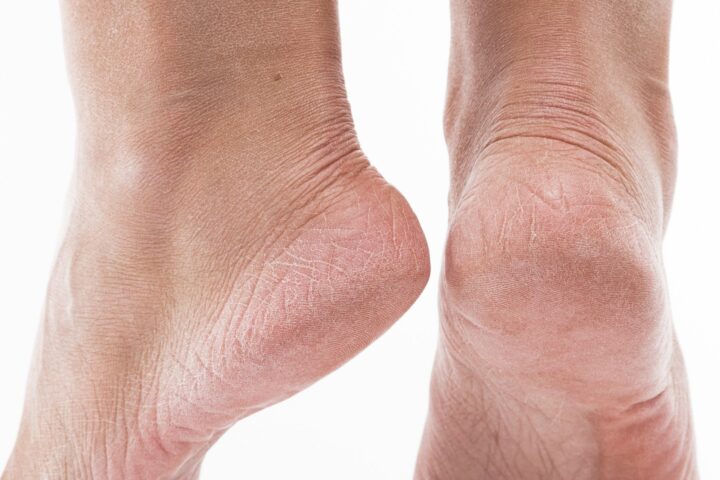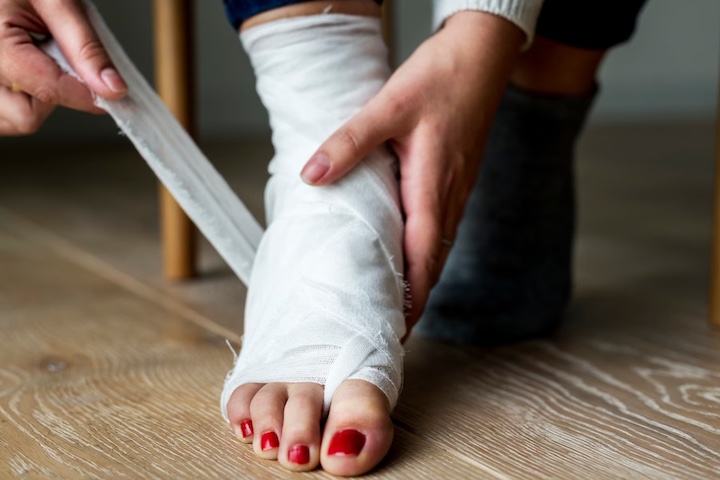If you’re struggling with foot pain, especially pain in the heel area, you’re not alone. Heel pain is a common foot complaint that various conditions and injuries can trigger. The discomfort can significantly affect your mobility and quality of life, whether it’s due to plantar fasciitis, Achilles tendinitis, or something else entirely.
Recognizing the symptoms of heel pain and injury early on is crucial for prompt diagnosis and effective treatment. The good news? There are several options available that can alleviate your discomfort and help you regain foot health. Additionally, specific prevention strategies can reduce your risk of future issues.
But remember, while self-care measures might work in some cases, severe or persistent heel pain warrants professional attention.
There’s a range of heel pain and injury types you could experience, from plantar fasciitis to Achilles tendinitis, each with its own unique set of symptoms and treatment strategies.
Plantar fasciitis is the most common cause of heel pain, resulting from inflammation in the thick band of tissue that connects your heel bone to your toes. This can lead to sharp stabbing pain, typically occurring with your first steps in the morning. Therapeutic options include rest, ice application, physical therapy exercises, and over-the-counter pain relievers.
Achilles tendinitis is another typical source of discomfort that affects your Achilles tendon, which attaches calf muscles at the back of the lower leg to your heel bone. Overuse or strain on this tendon may result in painful inflammation or even degeneration. Treatment often involves rest, physiotherapy, and occasionally orthotics.
Heel bursitis is another type of heel injury caused by excessive pressure or friction on the back part of the shoe, leading to swelling and redness around the area. The use of proper footwear coupled with anti-inflammatory drugs can aid recovery.
Understanding these different types won’t just help you pinpoint what might be causing your specific heel pain but also guide you towards appropriate treatments and preventive measures.
Struggling with a throbbing sensation in the base of your foot? It’s likely due to some common culprits like plantar fasciitis or Achilles tendinitis. Understanding these causes can help you manage and even prevent anything that could cause heel pain and injury.
The most common cause of heel pain includes:
Prevention and treatment methods typically involve rest, physical therapy, proper footwear, ice application, and medication for inflammation. Surgery may be recommended as a last resort when conservative measures fail to alleviate discomfort. Remember: A timely consultation can save you from prolonged agony.
Recognizing what your body is telling you through discomfort and aches at the base of your foot can be the first step in addressing an underlying issue promptly. When you start to experience heel pain, it’s important to pay attention to its nature and timing.

Photo Credit: Traima Kivan, Envato Elements
Heel pain symptoms can vary widely – from a sharp, searing pain often felt when taking the first steps in the morning, to a dull ache that worsens with prolonged standing or walking.
The type of heel pain you feel may also depend on where it’s located. Pain under the heel could indicate conditions like plantar fasciitis or bruising, while pain behind the heel might suggest Achilles tendinitis or bursitis. It’s also quite common for people suffering from stress fractures or nerve irritations to feel heel pain.
By recognizing these symptoms early on, you’ll be better equipped to seek timely medical intervention. Prompt treatment not only alleviates discomfort but can also prevent further progression of any potential damage – a crucial aspect in managing any heel pain and injury.
Bear in mind that prevention is always better than cure. Regular stretching exercises, supportive footwear, and maintaining a healthy body weight are key strategies for keeping painful heels at bay.
Getting the right diagnosis for your foot woes isn’t always a walk in the park, but it’s essential to find the pain relief you need. Determining what led to heel pain can be complex due to the intricate structures of the foot and numerous potential causes. Understanding how diagnosis works can empower you to communicate effectively with your healthcare provider and make informed decisions about your care.
Identifying your specific foot problems is paramount in determining appropriate treatment strategies tailored for you. Remember that open communication with your healthcare provider is key throughout this process. You’re not just a patient but an active participant in your journey towards pain-free walking!
Once you’ve pinpointed what’s causing your foot troubles, it’s like a breath of fresh air – relief is within reach, with an array of treatments tailored to help you reclaim the joy of unhindered movement.
The treatment options available for foot and ankle discomfort can be broadly categorized into conservative treatment methods and surgical interventions.

Photo Credit: RawPixel, Freepik
Conservative treatment options are usually the first line of action. These include rest, ice application, compression with elastic bandages, elevation of the affected foot, over-the-counter pain relievers, and anti-inflammatory medications. Physical therapy exercises designed to improve strength and flexibility in your feet may also be recommended as part of your treatment plan.
In addition to these measures, using heel pads or shoe inserts can provide extra cushioning to alleviate pressure on painful areas. More invasive procedures such as corticosteroid injections or surgery may be considered if conservative approaches don’t provide sufficient relief.
It would be best to work closely with healthcare professionals specialising in foot and ankle conditions. They can accurately diagnose your problem and guide you through the appropriate steps towards recovery. Treatments are designed not just for immediate relief but also to prevent recurrence by addressing the root cause of your heel pain and injury.
After tackling your foot discomfort with the right treatment, it’s all about bouncing back stronger through a well-planned rehabilitation and recovery process. This process is pivotal for anyone who’s experienced heel pain and injury. The goal here is to reduce chronic heel pain, improve mobility, and prevent future occurrences.
The first step in your rehabilitation journey usually involves physical therapy exercises designed to strengthen your foot muscles while improving flexibility and balance. These exercises are essential in preventing further complications of heel pain such as plantar fasciitis or Achilles tendonitis. Sometimes, your therapist may also incorporate massages or recommend orthotic devices to redistribute pressure away from your affected foot.
Another key aspect of recovery is lifestyle modification, which includes maintaining a healthy weight, wearing appropriate footwear, and regularly performing low-impact activities like swimming or cycling. These small changes can significantly aid your recovery while reducing the risk of recurrence.
Maintaining consistent communication with your healthcare provider throughout this entire process is equally important because it allows them to monitor progress and adjust treatments as necessary. Remember that patience during this period is crucial – complete healing takes time, but every step you take brings you closer to being free from your heel problems once more.
To ward off any future discomfort, it’s absolutely essential to embrace prevention strategies that’ll fortify your feet against potential issues. You can effectively prevent heel pain and injury with the right measures in place. By understanding what can cause pain at the base and sole of the foot, you can tailor your approach accordingly.

Photo Credit: Drazen Zigic, Freepik
One of the crucial ways to protect your heels involves wearing appropriate footwear. You should consider:
Incorporate strength training into your routine. Exercises targeting foot muscles improve overall mobility and safeguard against injuries.
Avoid overexerting yourself during physical activities as this could lead to strain or damage your heels. Listen to your body; if a certain activity causes discomfort, then it’s time for modification or rest.
You’re taking proactive steps towards maintaining healthy feet by employing these prevention strategies for future issues. Remember, managing heel health is a lifelong journey. Therefore, consistently applying these principles will go a long way in ensuring you stay ahead of potential problems without compromising your active lifestyle.
While you can take preventative measures to avoid heel pain and injury, knowing when to seek professional help is crucial. It’s a common misconception that all types of heel pain will naturally resolve over time. However, this is not always the case.
Heel pain is common among active individuals and can significantly impact your daily activities. If your pain persists despite rest, icing, and over-the-counter treatments, don’t ignore it. Persistent or severe heel pain may signal a more serious condition such as plantar fasciitis or Achilles tendinitis.
A podiatrist is a specialist with extensive training in diagnosing and treating foot conditions. They are the best professionals to consult when dealing with persistent or severe heel issues. If your pain is severe enough that it hinders walking or usual activities, seeing a podiatrist should be an immediate step for diagnosis and treatment plans.
Understanding when to seek professional help for your heel injury is as important as prevention strategies. This knowledge could save you from prolonged discomfort and potential long-term damage to your feet. So remember: if the severity of your symptoms increases or if they persist longer than expected – don’t hesitate; reach out for professional help promptly.
To alleviate heel pain and injury, it’s important to determine the underlying cause first. Common remedies include resting the affected foot, applying ice packs, using over-the-counter pain relievers, wearing supportive shoes or orthotics, doing stretching exercises, and possibly undergoing physical therapy. For persistent or severe pain, it’s advisable to consult with a healthcare professional for a proper diagnosis and personalized treatment plan.
The primary cause of heel pain is often attributed to plantar fasciitis. It occurs when the plantar fascia, a thick band of tissue connecting the heel bone to the toes, becomes inflamed or strained. Other causes of heel pain include Achilles tendinitis, heel spurs (bony outgrowths on the heel bone), bursitis, stress fractures, and certain medical conditions like arthritis or nerve entrapment.
Heel bursitis is characterized by inflammation of the bursa, a fluid-filled sac located near the heel. Common symptoms include swelling, tenderness, warmth, and pain at the back of the heel or under the heel bone. The pain may worsen with activities that pressure the affected area, such as walking, running, or wearing tight shoes. If you suspect heel bursitis, it’s advisable to seek medical attention for proper diagnosis and treatment.
Plantar fasciitis heel pain is often described as a sharp, stabbing sensation in the bottom of the foot near the heel. It is typically worse in the morning or after periods of rest, as well as after prolonged standing or activity. The pain may ease with movement but can worsen after extended periods of walking or running. Some individuals also experience a dull ache or tightness along the arch of the foot. Consulting with a healthcare professional can help confirm the diagnosis and guide appropriate treatment.